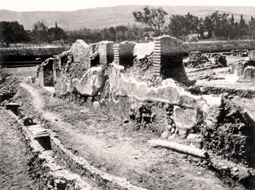Autori: L.M. Caliò, A. Fino, G.M. Gerogiannis
Scarica l’articolo in formato .pdf: La krene nell’area del teatro di Agrigento: dati preliminari
 Nel presente contributo sono riportati i primi risultati delle ricerche condotte ad Ovest dell’area del teatro di Agrigento, con l’obiettivo di comprendere e precisare i limiti dell’ampio spazio pubblico su cui l’edificio di spettacolo insiste. Gli scavi di questo settore si pongono infatti in continuità con quelli del teatro, di cui costituiscono quasi un’appendice. L’area, indagata a partire dal 2017, ha restituito negli anni una stratigrafia articolata di strutture sovrapposte che nel 2022 hanno portato a riconoscere nei livelli più bassi raggiunti dallo scavo una krene la cui realizzazione potrebbe essere inquadrata nell’ambito dell’attività edilizia di Terone. L’importanza del rinvenimento è tanto più grande se si pensa che all’articolato sistema di gestione delle acque, costituito da cunicoli, ipogei e raffinati sistemi di captazione, fino ad oggi in tutta l’estensione della città antica era nota soltanto una fontana monumentale presso il c.d. Santuario Rupestre in località S. Biagio. Le acquisizioni, inoltre, sono tali da alimentare un rinnovato interesse nei confronti delle tematiche legate all’archeologia dell’acqua e in particolare di come questa fosse vissuta nel quotidiano anche nell’organizzazione urbana e sociale delle città antiche.
Nel presente contributo sono riportati i primi risultati delle ricerche condotte ad Ovest dell’area del teatro di Agrigento, con l’obiettivo di comprendere e precisare i limiti dell’ampio spazio pubblico su cui l’edificio di spettacolo insiste. Gli scavi di questo settore si pongono infatti in continuità con quelli del teatro, di cui costituiscono quasi un’appendice. L’area, indagata a partire dal 2017, ha restituito negli anni una stratigrafia articolata di strutture sovrapposte che nel 2022 hanno portato a riconoscere nei livelli più bassi raggiunti dallo scavo una krene la cui realizzazione potrebbe essere inquadrata nell’ambito dell’attività edilizia di Terone. L’importanza del rinvenimento è tanto più grande se si pensa che all’articolato sistema di gestione delle acque, costituito da cunicoli, ipogei e raffinati sistemi di captazione, fino ad oggi in tutta l’estensione della città antica era nota soltanto una fontana monumentale presso il c.d. Santuario Rupestre in località S. Biagio. Le acquisizioni, inoltre, sono tali da alimentare un rinnovato interesse nei confronti delle tematiche legate all’archeologia dell’acqua e in particolare di come questa fosse vissuta nel quotidiano anche nell’organizzazione urbana e sociale delle città antiche.
This paper reports the preliminary results of the research carried out west of the theater area of Agrigentum, with the aim of understanding and specifying the boundaries of the large public space in which the complex insists. The excavations of this sector, in fact, stand in continuity with those of the theater, constituting almost an appendix. The area, excavated since 2017, has returned over the years an intricate stratigraphy of overlapping structures that in 2022 led to the recognition of a krene in the lowest levels, the making of could be framed as part of the Teron construction activity. The importance of the discovery stands in the fact that at the complex water management system, consisting of galleries, hypogea and fine catchment systems, only a monumental fountain is known until now in the entire extention of the ancient city at the so-called Santuario Rupestre in S. Biagio. The achievements, moreover, are fueling a renewed interest in issues related to the water archaeology and particularly how it was experienced in daily life even in the urban and social organization of ancient cities.

